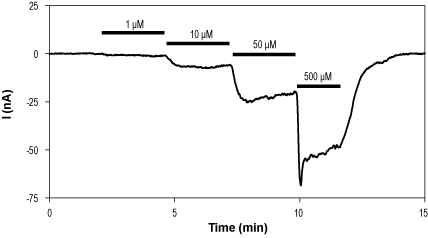Overview
- Allan, R.D. et al. (1990) J. Med. Chem. 33, 2905.
- Erreger, K. et al. (2007) Mol. Pharmacol. 72, 907.
 Alomone Labs cis-ACBD activates NMDA receptors (NR1+NR2A) expressed in Xenopus oocytes.Time course of NMDA receptor current activation by 1 to 500 μM cis-ACBD (#A-281) (at -80 mV). Amplitude change as a result of the application of rising concentrations of cis-ACBD (perfusion duration indicated by the horizontal bar, concentration as indicated).
Alomone Labs cis-ACBD activates NMDA receptors (NR1+NR2A) expressed in Xenopus oocytes.Time course of NMDA receptor current activation by 1 to 500 μM cis-ACBD (#A-281) (at -80 mV). Amplitude change as a result of the application of rising concentrations of cis-ACBD (perfusion duration indicated by the horizontal bar, concentration as indicated).
- Fletcher, E.J. et al. (1991) Neurosci. Lett. 121, 133.
- Allan, R.D. et al. (1990) J. Med. Chem. 33, 2905.
- Talukder, I. et al. (2010) J. Neurosci. 30, 11792.
trans-ACBD is a potent, competitive and selective activator of glutamate uptake. The compound acts as an NMDA (N-methyl-D-aspartate) receptor agonist. The ACBD structure includes two isomers: cis-1-aminocyclobutane-1,3-dicarboxylic acid and trans-1-aminocyclobutane-1,3-dicarboxylic acid. Several studies have shown that the trans isomer is more potent than the cis isomer. The trans isomer was also shown to be 20 times more active than NMDA1,2, the major excitatory neurotransmitter in the mammalian central nervous system (CNS).
Several studies suggest that modifications and changes of glutamate uptake could play a role in processes underlying synaptic plasticity in the CNS2.
NMDA receptors are ion channels gated by glutamate. Glutamate-mediated signaling is important for basic neuron-neuron signaling and neuronal processes such as learning, memory and pain perception3.
cis-ACBD (#A-281) is a highly pure, synthetic, and biologically active compound.

